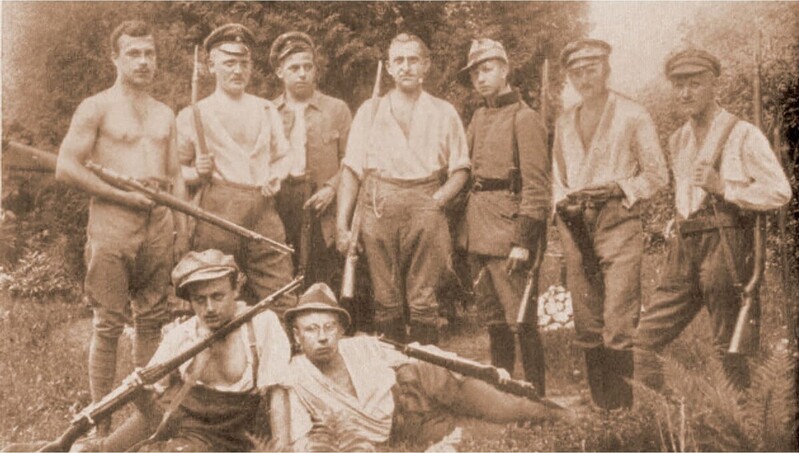The German underground, which could have responded to the actions of the Plebiscite Defence Command, i.e. KOOS (Kampf-Organisation OberSchlesiens), was paralysed already on the eve of the plebiscite, when the coalition forces, using information from Polish intelligence, conducted raids on its premises and weapon warehouses. Armaments were lost, many conspirators were arrested, and the rest had to seek refuge in Germany. It is no wonder then that only a week after the uprising started, the insurgent army managed to reach the Korfanty Line, postulated as the future Polish-German border. They encountered no significant resistance along the way, and if they did, it was put up by Italian coalition troops. The remnants of the KOOS either retreated west, or confined themselves to the few cities that remained under Allied protection.
The German response was to be the Self-Defence of Upper Silesia (Selbstschutz Ober-Schlesiens, or SSOS), the seed of which had already begun to form during the insurgent offensive, initially in the south, near Ratibor (Racibórz), and later also in the north, near Kreuzburg (Kluczbork). In the former of those places, as early as on 7 May, Gen. Bernhard von Hülsen (born in Cosel [Koźle]) arrived from Potsdam, in the latter, the SSOS was organised by Lt. Col. Grützner. Soon the front was divided into three operational units, called groups: “South” (Gen. Hülsen), “Central” (Col. von Holleben) and “North” (Lt. Col. Grützner). However, it was not until 20 May that overall command was assumed by Pleß (Pszczyna)-born Gen. Karl Hoefer, in 1919 commander of Grenzschutz. As the insurgents were not active in the central section of the front, he eliminated Col. von Holleben’s section, but reinforced the forces in the bridgehead in Krappitz (Krapkowice), and moved his headquarters to Oberglogau (Głogówek). All this pointed to preparations for a counter-offensive.
For the time being, however, the appropriate forces had to be gathered. Initially, they consisted of local self-defence units; when Hoefer took command, those unfit for frontline service were separated from them and formed into militia units (the so-called Ortswehr), while the rest were concentrated in marching battalions. However, the area under German control soon saw an influx of volunteers from the interior of the country (and even from beyond), often grouped together in compact formations. These were often units that had already taken part in battles against external or internal enemies, and thus re-established forms of various volunteer corps (freikorps) from 1918–20. As early as 10 May, for example, companies of the Freikorps Oberland arrived from Bavaria; their numbers soon grew to 2,000 frontline soldiers. Breslau students formed the “von Eicken assault company”, which later fought as part of the “Heinz assault battalion”; this, of course, refers to Ensign “Heinz” Hauenstein, head of the notorious Spezialpolizei, responsible for numerous assassinations. Aristocrats from Upper Silesia, such as Hyazinth Graf Strachwitz or Hans Heinrich XV von Hochberg, Prince of Pleß (Pszczyna), formed their own units.
The rallying point for the incoming volunteers became the Brieg (Brzeg) airfield, where they were split into individual companies and battalions; the latter constituted the highest tactical unit, although their numbers rarely conformed to accepted norms. The German government, semi-officially supporting the creation of the SSOS, looked with barely concealed concern especially at the members of the former Freikorps, who were imbued with a radically anti-republican spirit. Similarly, the reactivation of the former Freikorps was welcomed by the German land governments; those where the Social Democrats or Liberals remained in power tried in many ways to obstruct the passage of volunteers and the transport of armaments. It is no wonder; in the notes of one of the SSOS leaders of the time, “Peter” von Heydebreck (Kandrzin [Kędzierzyn] was renamed “Heydebreck O/S” in his honour in 1934), there is a glimmer of hope that the action in Upper Silesia would be the beginning of a crackdown on republican reality. “We can deal with the Poles”, von Heydebreck wrote.
“I know that we are just now being given a great opportunity, because the victorious army will not allow itself to simply be sent home again. Woe to him who dares to dissolve it – then videant consules (Latin: let the consuls beware)”.
In mid-June 1921, the Upper Silesian Selbstschutz reached the apogee of its development.
Gen. Hoefer had at his disposal a general staff headed by Maj. Jacobsen, and the so-called Headquarters of Colonel Becker in Breslau, acting as a link with the rest of Germany. In addition to the two groups, which were divided into a total of seven sections, the most valuable special formations, usually derivatives of the former Freikorps, remained at Hoefer’s personal disposal. It was they who largely contributed to the success of the German counter-offensive.
While, especially recently, historians have generally agreed that the SSOS could not have numbered more than 40,000 fighters in total (and this figure applies to the final stage of the struggle), the numerical ratio of Upper Silesians to outsiders is still a matter of dispute. The latter certainly made up a significant part of the units fighting on the front line (such as Freikorps Oberland or Freikorps von Heydebreck), and were therefore more noticeable. However, as early as 1921, Selbstschutz biographer Hermann Katsch counted 176 Upper Silesians killed in its ranks, including those with such familiar names as Banka, Blaschak, Hruzik, Juretzka, Kluczny, Pawlik, Stoklossa or Zurek. This matter is certainly worth a closer look.
